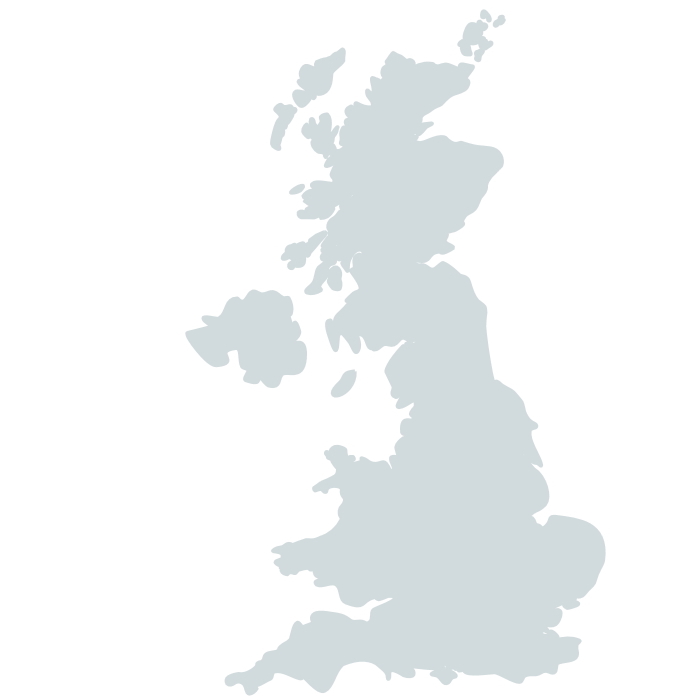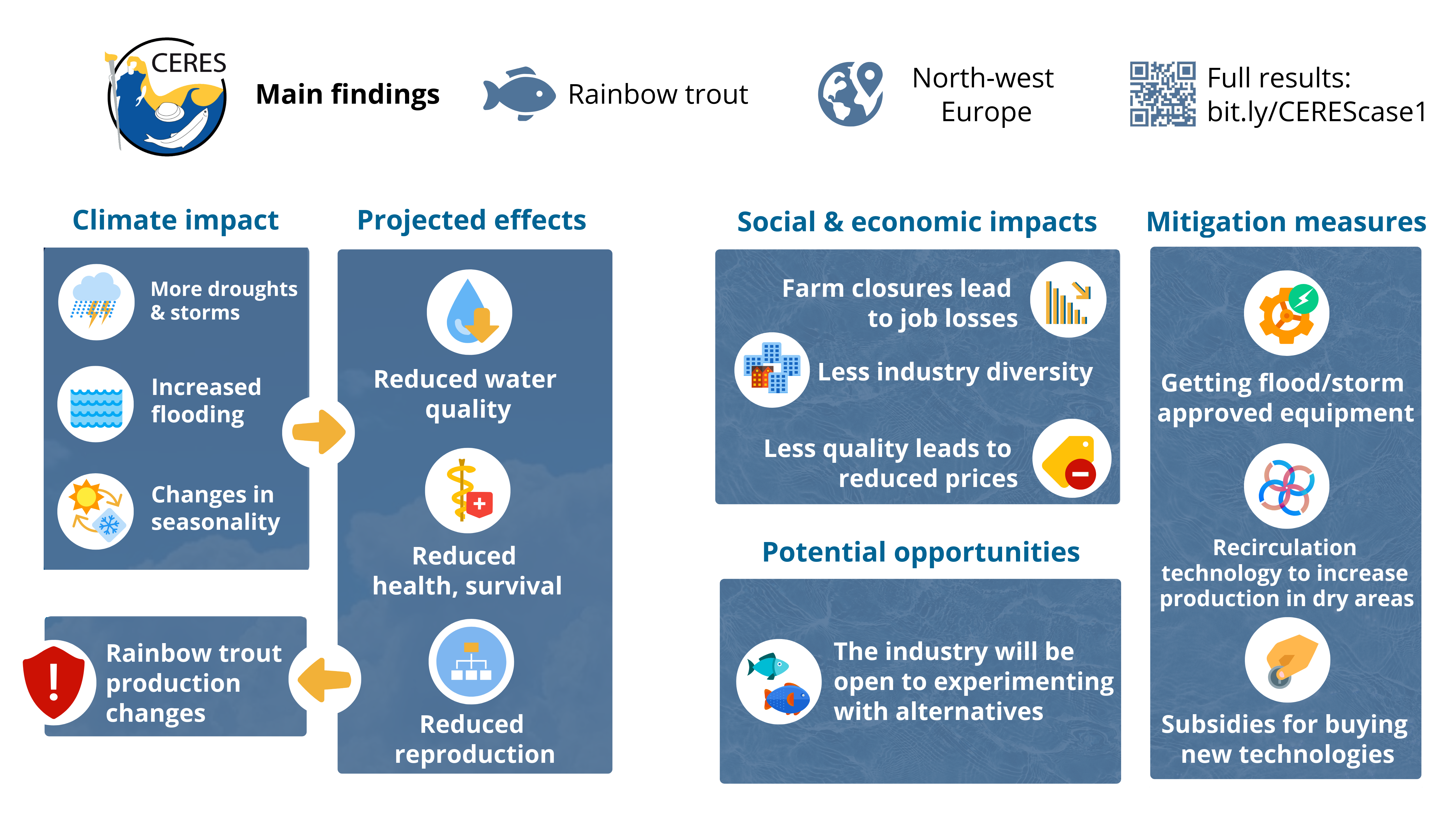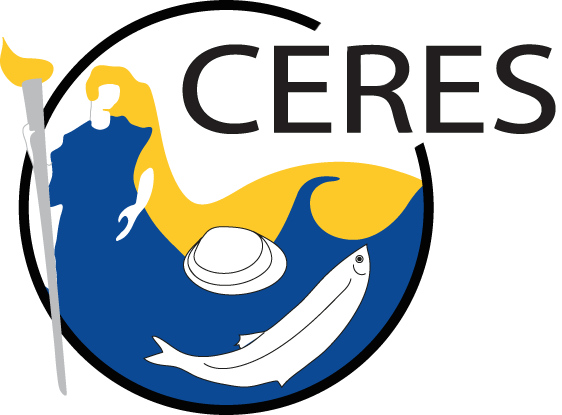

Case study 1: Rainbow Trout in north-west Europe
Rainbow trout (Oncoryhnchus mykiss) is one of the most widely-introduced species worldwide. It was introduced to European countries from the USA during the end of the 19th century, which was then followed by transfers within Europe.
Rainbow trout is now the most produced aquaculture finfish in the EU, in both volume and total value. Growing best at around 9-20°C, they are raised in places such as earthen and concrete ponds, raceways, net cages and recirculation aquaculture systems.
In Denmark, England, and Germany, most common production is ‘portion-sized’ trout in small farms, often depending on local markets and tradition.

Denmark
is the most important trout exporter within the EU. In 2016 the country produced 20,970 tons of portion-sized trout with a value of €63.2 million. The trout sector consists of 190 inland trout farms, located predominantly in mid-Jutland and in southern Denmark. The main export market is the EU, particularly Germany

Germany
produced 7,039 tons of rainbow trout in 2016, valued at €39 million and is the main EU importer of trout. The main domestic production occurs in the southern states of Bavaria and Baden-Württemberg

The UK
has maintained its annual production of 12,000 – 17,000 tons over the past two decades. England alone produced 4,852 tons in 2016 with a value of €19.5 million. Two-thirds of UK trout produced is sold domestically; demand for imported trout is low
What we expect to happen under climate change
The surface temperatures of German, English and Danish freshwaters are forecasted to increase by around 2% under a medium emission scenario (Representative concentration pathway 4.5 = RCP 4.5). Under a high emission scenario (RCP 8.5) they are projected to increase by around 6% over a year within the 2040-59 period.
Some regions will experience different changes of temperature. These changes, which could be even more intense as seasons change, will directly affect rainbow trout production.


Within England
the greatest water temperature increases are expected in southern, western and eastern regions, increasing by 1.2% under RCP 4.5 and 5% under RCP 8.5 during summer months. As a consequence, temperature suitability, according to optimal growing temperature of rainbow trout, will decrease for the south east.

Germany
is expected to experience higher summer temperatures of 4.3% (under RCP 4.5) and 7.9% (RCP 8.5) respectively within Bavaria and Baden-Württemberg. This will lower their trout-growing suitability under RCP 8.5.

In Denmark
projections suggest that there will be less variation between different producing regions. No change in temperature suitability was predicted based on annual proportion of days within the optimal temperature range for trout. But it has to be kept in mind that peak temperature development is a very important factor as well.
Rainfall
In the RCP 4.5 scenario Denmark, the UK, and Germany are predicted to have increased summer rainfall (up to 7.5%) by 2050.
Denmark is also likely to see increases in summer precipitation under RCP 8.5 in 2050, but there is likely to be a small reduction in summer rainfall in the UK and Germany under this scenario.
Winter rainfall is due to increase in all countries under both RCPs except for under RCP 4.5 in Denmark and the UK which are predicted to experience little or no change (respectively) under both scenarios. Winter rainfall is predicted to increase substantially in Germany under both RCPs in 2050, which could enhance the risk of flooding.
More local projections for RCP 8.5 and similar scenarios) show that the south of Germany (Bavaria and Baden-Württemberg) will have more extreme regional variation in rainfall pattern predictions than the those discussed above.
Mid-century projections show river flow rates decreasing by up to 10% in Denmark. Conversely an increase of up to > 10% is predicted for eastern and coastal Germany, with both changes higher under the high-emissions RCP 8.5 scenario. Projections for England show decreasing flow under the moderate-emissions RCP 4.5 scenario but increasing under RCP 8.518.
Note: The projections should be considered to have high uncertainty.
CERES research
CERES researchers analysed the future profitability of trout farming in the UK, Germany, and Denmark using these RCP scenarios.
With these objectives in mind, researchers did the following:
- literature review, a GAP analysis and a Meta-analysis to examine direct effects of climate change on survival and growth physiology
- forecasted fishmeal and fish oil prices to estimate future feed prices across the CERES scenarios
- together with projections on other future fish feed component prices
- sourced projections on future fuel and electricity prices as well as fish prices to calculate future energy costs and returns
- created models for typical rainbow trout farms in Germany, Denmark, England and projected the biological and economic effects of climate change on these farms.
- developed maps of disease risk and farm suitability based on changes in disease risk across north-west Europe
- applied a trade model to find the impact on the fisheries and aquaculture sectors and indirect impacts on related sectors in Denmark, Germany and the UK.
- created a diagram including perspectives on cause-and-effect relationships between climate change and future aquaculture production of rainbow trout.
- ranked the vulnerability of Europe’s most valuable farmed finfish and shellfish to climate change, including trout in the north-west of Europe
- talked to the rainbow trout aquaculture industry (including fish feed production and fish health inspectors)

Results – Biology
In the medium-term (2040-59), suitable habitats and seasonal windows for several diseases and pathogens known to impact European trout farms (e.g. furunculosis) are projected to increase across Germany, Denmark and England.
Some pathogens are expected to be more suitable to temperatures associated with RCP 4.5 in the year 2050 (e.g. infectious hematopoietic necrosis suitability across the UK). Others show the greatest suitability under RCP 8.5 (e.g. proliferative kidney disease suitability across Germany).
However, there are exceptions.
- Not all viruses will find a more suitable environment because of such temperature increases.
- There may be occasions where suitability actually decreases because of the future scenarios (e.g. enteric redmouth disease across the UK and Germany in response to both RCPs).
Despite such decreases, the new environment will remain suitable for some and the potential for infections persists. If the environmental changes also impair fish health, the risk would be magnified.
In the event of decreasing oxygen levels, extreme precipitation events and general thermal stress, cultured finfish are known to become more susceptible to the diseases and pathogens discussed above and the potential future distributions of pathogens will dictate the impacts and management to trout farms across Europe.

Predicted consequences of the four CERES climate change scenarios on the profits of small German rainbow trout farms. This includes the future price projections, habitat temperature, and disease suitability from 2050 onwards. Image: C.Kreiss.
Results – Economy
Future profitability is dependent on the profit margin and model predictions suggest that the Global sustainability scenario (a global and green RCP 4.5 scenario) will result in the least profitability of the four modelled scenarios.
Model predictions suggest that a typical Danish farm, with a 2016 profit margin of around 7% will not be profitable under any of the four future scenarios. Conversely, professional German best practice farms with a 2016 profit margin of over 50% will become even more profitable under all future scenarios.
Farms with a profit margin around 20% are still profitable under all scenarios, although operating earnings under the Global Sustainability (GS) Scenario are already quite small.
A best practice English trout farm with a 2016 profit margin of 11.55% will not be profitable under the GS scenario and would only just be profitable under the three other scenarios. With the exception of professional German farm sites, all four CERES scenarios will have a negative effect on the profitability of trout farming if no adaptations are made to practices or supply chains and markets.
Predictions averaged across the trout sector as a whole show that overall cash costs will increase more than returns under all four CERES scenarios leading to reduced profitability in the future.
Cash costs and return increase is least favourable for the GS scenario, followed by National Enterprise (local RCP 8.5 scenario), World Market (global RCP 8.5 scenario) and Local Stewardship (local RCP 4.5 scenario) with very little cash cost variation between the different farms.
This leads to the observed results distribution with farms being least profitable under the GS scenario, but most profitable under LS. The reason for this are amongst others the comparably low fish prices under GS.
Fish prices are derived from scenario changes in population, income, international trade, agricultural expansion and technological change as major drivers for long-term changes in world food prices. Thereby GS shows lowest demand for agricultural commodities, resulting in more rapid growth in agricultural productivity and globalised trade.
Taking the results one step further and including information on future temperature suitability and disease risk to include a spatial component, by placing the typical farms across their original countries the most and least suitable regions can be identified.
Solutions
Expected changes in precipitation and an increase in surface water temperature for NW Europe are pushing towards or exceeding the thresholds for water temperature and the quality of rainbow trout. This means a decline in fish health and potentially reduced survival. This will damage rainbow trout production.
Increased winter rainfall and regional increase in river flow could cause an increased frequency of flooding and damaging farms. Adaptation measures will increase operational costs (e.g. energy costs to increase aeration) and, if these measures are not sufficient or exceed profit, relocation of aquaculture with reduced local employment could be the consequence.
Mitigation measure options from governmental site include subsidies to enable the adoption of new technologies to overcome increased droughts, floods and/or decreased water quality. In case that physiological thresholds of the cold water species rainbow trout are exceeded alternative rainbow trout strains, e.g. selected for higher thermal tolerance could be an option.

